Volume 44, Issue 12
New Report: 2000-2020 Travel Trends in the Philadelphia Central Business District
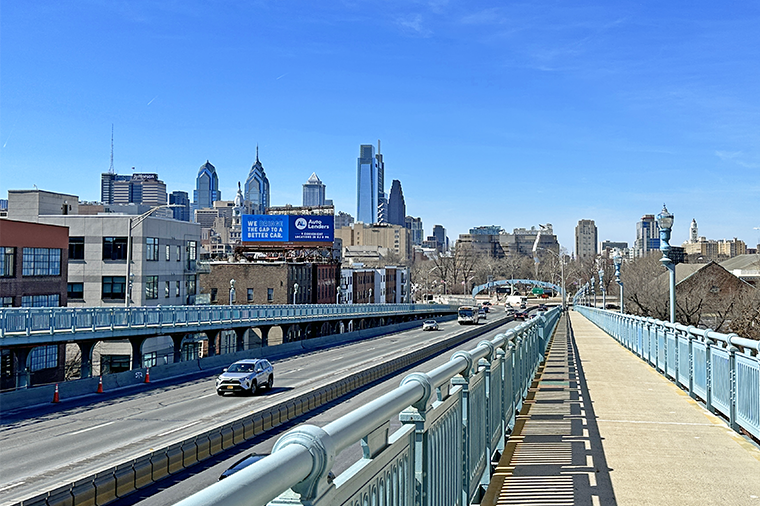
A new report, 2000-2020 Travel Trends in the Philadelphia Central Business District, documents the changes in travel to and from Philadelphia’s Central Business District (CBD) between 2000 and 2020. This was a period of major change due to the Great Recession from December 2007 to June 2009, and the Coronavirus (COVID-19) pandemic, beginning in March 2020. The report compares auto, transit, bike, and pedestrian trips collected in 2000, 2005, 2010, and 2015 to data from just before COVID-19 in the fall of 2019, as well as data from during COVID-19 in the summer of 2020.
Short-term travel trends from 2015 to the fall of 2019 are slightly negative, with decreases across all modes and across three of the four screenlines surrounding Center City. On average, 1.9 million people traveled to and from Center City each weekday in the fall of 2019, a decrease of 1.3 percent from 2015. During this time, there was not much change in mode split. Pedestrian trips declined slightly from 5.4 percent of total trips to 5.1 percent. Bicycle trips remained the same at 0.9 percent. Transit trips declined from 26.9 percent to 26.2 percent, and highway trips increased from 66.9 percent to 67.8 percent.
Longer-term travel trends from the end of the Great Recession in 2009 to early 2020 are mostly positive, across all screenlines and modes of travel. However, this all changed in March of 2020 with the onset of COVID-19 and its drastic impact on both the economy and travel behavior in the CBD and throughout the Philadelphia region. Evidence suggests that there may be fundamental changes to underlying travel behavior. For example, as of fall 2022, only 50 percent of office workers in Center City have returned to working from their offices. At this point in time, it is still unclear what the long-term impacts of COVID-19 will be in terms of land use and transportation planning. To learn more, view the full report.
DVRPC Approves $11.2 Million for Bicycle and Pedestrian Projects in NJ

The DVRPC Board has approved $11.2 million toward nine projects in New Jersey through the Transportation Set-Aside Program (also known as TA-SA). The program distributes federal transportation funds for community-based, non-traditional projects that strengthen the cultural and environmental aspects of New Jersey’s transportation system.
They include:
- Lawrence Station Road Connector Trail in Lawrence Township, Mercer County ($1,260,000)
- Pavilion Avenue Streetscape Improvements in Riverside Township, Burlington County ($746,000)
- Township of Mount Holly Streetscape Project in Burlington County ($559,000)
- Main Street - North-South Bike/Ped Connector at Church, Wilkins Station, Route 70, Main, and Stokes in Medford Township, Burlington County ($1,486,000)
- Burlington-Camden Trail with Bridge over Route 130 in Pennsauken Township, Camden County ($1,225,000)
- Phase 6 Bikeway and Streetscape Improvements along Lakeview Drive in Gibbsboro Borough, Camden County ($1,500,000)
- Camden County LINK Trail, Segment IE Project in Camden County ($1,500,000)
- City of Woodbury Pedestrian Path Network along Hester’s Branch and Woodbury Creek in Gloucester County, ($1,500,000)
- Elephant Swamp Shared-Use Trail Improvements in Elk Township, Gloucester County ($1,408,000)
Visit the DVRPC TA-SA website to learn more about the program.
See How the Region is Achieving Long-Range Plan Vision on New Tracking Progress Dashboard
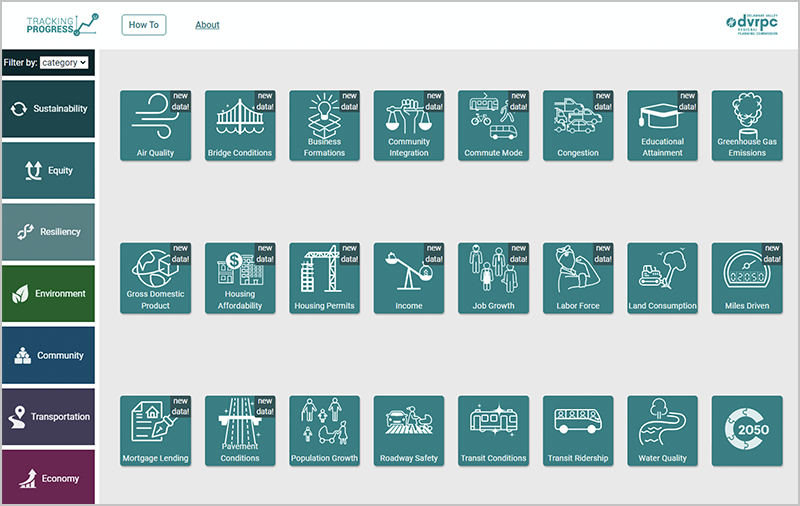
Tracking Progress has been updated with new data and indicators. Tracking Progress is an award-winning interactive dashboard for exploring regularly updated data to gauge our progress toward achieving the Connections 2050 vision of an equitable, resilient, and sustainable Greater Philadelphia region.
The new dashboard includes three new indicators, including Business Formations, Gross Domestic Product, and Mortgage Lending Disparities. Another new feature is the ability to access the Data Catalog directly from the charts. The effects of the COVID-19 pandemic can be seen in many of the 16 updated indicators. For example, there was a 10% drop in commuters driving alone in 2021. This was largely due to the 15% gain in employees working from home in 2020 and 2021, with telecommuting representing nearly a quarter of all commutes in 2021. In addition, there has been unprecedented growth stemming from economic shifts during the pandemic. Years 2020 and 2021 experienced successive, record-breaking business formations, with annual applications 66% higher in 2021 than 2019.
Regional indicators are used to communicate how the region is performing at a given time period, identify successful programs, align DVRPC's planning and implementation activities, and inform regional strategies. The data in Tracking Progress is also a valuable resource for other planners, analysts, and anyone interested in the conditions and future of Greater Philadelphia.
Check DVRPC’s newsroom and follow @DVRPC on social media for #TrackingTuesdays which will feature regular data updates and analysis. Explore the Tracking Progress dashboard.
Share Your Transportation Concerns in a Paid Focus Group

Transportation infrastructure gets us where we need to go, but it can also come with challenges related to travel costs, access, community cohesion, air quality, noise, visual quality, and construction. Historically, negative impacts from transportation projects have been disproportionately experienced by communities of color and low-income persons. DVRPC wants your help to better identify and reduce negative impacts in the future.
DVRPC is actively recruiting people who live in traditionally marginalized and underserved communities to participate in a paid focus group to discuss the impact of transportation projects affecting their communities and daily lives. If you or someone you know is interested in participating, please fill out an interest form. Those who are selected to participate will receive a financial stipend. To learn more, visit www.dvrpc.org/ej.
Vision Zero: Hunting Park Open House is June 17
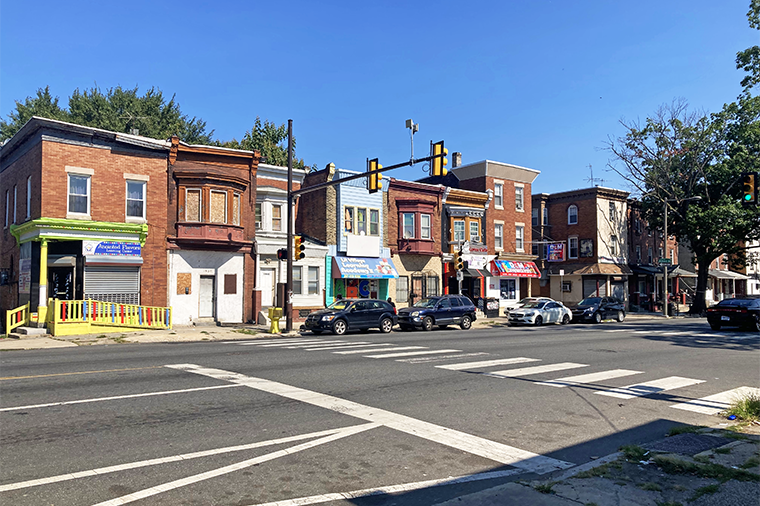
Do you walk, bike, or ride on Hunting Park Avenue? DVRPC and the City of Philadelphia want to make traveling on Hunting Park Avenue safer for pedestrians, cyclists, and all users of the road. On Saturday, June 17, they are hosting an open house from 11 am - 2 pm at Carlisle Street Park (the triangle at the Hunting Park Ave. and Roosevelt Blvd.) to share their traffic safety recommendations with the community. Come view the recommendations, share your feedback, and enjoy free food from Wraps & Snacks! Rain date is Saturday, June 24.
If you’re unable to attend the event, you can view the recommendations and share your feedback online beginning June 12. To learn more about the project and sign up for project updates, visit www.dvrpc.org/huntingpark.
Webinar on June 21: Join Us for Off-Peak: Assessing the Hospitality and Tourism Industry's Recovery from COVID-19
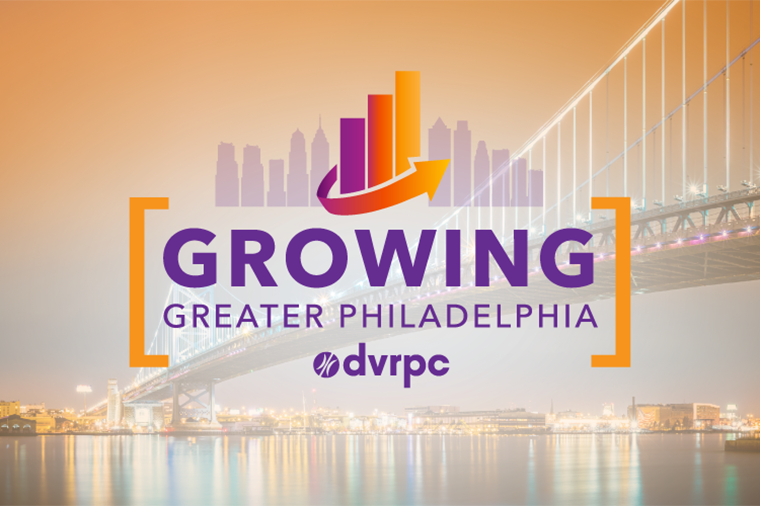
Join DVRPC on Wednesday, June 21, at 2:00 pm, for the webinar “Off-Peak: Assessing the Hospitality and Tourism Industry's Recovery from COVID-19.” Unlike most sectors, the hospitality and tourism industry has yet to return to pre-pandemic 2019 employment levels. While consumer demand has rebounded, employers, especially hotels and restaurants, are struggling to hire and retain employees due to numerous factors, including low wages and the place-based nature of these jobs that limits the ability of employees to work remotely.
This webinar will feature a panel of experts who will discuss how demand has changed from the pandemic-related shutdowns to today. Topics include: labor shortages, particularly in accommodation/food services and hotels/motels; low occupational wage; a gap in necessary skills for employees and how those are evolving; and A.I. and automation’s current and future impact on entry- and mid-level employment. Learn more and register.
Infrastructure Investment and Jobs Act Update

Through the Infrastructure Investment and Jobs Act (IIJA), the DVRPC region has been awarded over $260 million in competitive grant funds to support projects that will improve our region’s infrastructure. Projects that have received funding include:
- Regional Vision 2050 Action Program - The program was awarded $1.47 million in February through the Safe Streets for All (SS4A) Grant Program.
- Philadelphia Vision Zero Capital Plan Implementation - Safe Streets for All awarded the project with $30 million in February to construct safety improvements along key corridors located in historically disadvantaged communities and areas of persistent poverty.
- Roosevelt Boulevard: Route for Change 2025 near-term improvements - Awarded $78 million in January through MEGA (MultiModal Project Discretionary Grant Opportunity (MPDG)).
- Great Streets Philadelphia Project - Awarded $25 million through the Rebuilding American Infrastructure with Sustainability and Equity (RAISE) Program to implement critically needed transportation safety improvements along key corridors located in historically disadvantaged communities as well as areas of persistent poverty.
- SEPTA’s Broad Street Line/MFL Accessibility Improvements - The All Stations Accessibility Program (ASAP) awarded the project with $56 million to make six transit stations on the Broad Street and Market-Frankford Lines fully ADA accessible.
- Port of Camden Access and Infrastructure Resiliency Project - Awarded $25 million through the Port Infrastructure Development Grant.
- Reconnecting Our Chinatown: Reclaiming Philadelphia’s Vine Street Expressway - Reconnecting Communities awarded the project with $1.8 million.
The IIJA has recently announced several new Notice of Funding Opportunities (NOFOs). The most recent announcements include:
- April 28, 2023 - The Reduction of Truck Emissions at Port Facilities Grant Program makes $400 million available across the US to decrease emissions from heavy-duty trucks working at port facilities. Applications are due June 26, 2023.
- April 21, 2023 - The Promoting Resilient Operations for Transformative, Efficient, and Cost Saving Transportation (PROTECT) Discretionary Grant Program will be accepting applications until August 23, 2023.
- April 4, 2023 - Applications for the 2023 round of the Safe Streets for All are open until July 10, 2023.
- April 4, 2023 - The Wildlife Crossing Pilot Program applications are due August 1, 2023.
DVRPC may be able to assist local governments in applying for competitive grants. Visit the IIJA webpage for more information, or use this form to request a consultation. To receive periodic emails about Notice of Funding Opportunities associated with the IIJA, please sign up for our email list. If you have questions, contact Sean Greene, Manager, Office of Freight and Clean Transportation, at sgreene@dvrpc.org.
Opening July 1: Travel Options Program Expression of Interest

DVRPC is excited to announce the next round of grants for the Travel Options Program (TOP). The Expression of Interest (EOI) period will open on July 1, 2023; this is the first submission required in a two-step application process.
TOP funds creative and innovative projects that will decrease the amount of single occupancy vehicles on the region’s roadways - a concept known as Transportation Demand Management (TDM). TOP funds planning and implementation projects that aid the goals created in A New Route to Better Travel for All: The Regional TDM Plan. Projects must address a TDM issue and solution, with some form of measurable results.
EOIs are submitted through a uniform, electronic template with pre-populated questions that allow applicants to explain their project and how it addresses the Regional TDM Plan goals. To be eligible for EOI submission, applicants must attend a mandatory information session. EOIs are due on September 15, 2023 at 5 pm. This program is competitive and a select number of applicants will be invited to submit a full application, due in December.
Interested in learning more? Check out the TOP webpage to check eligibility and then attend a mandatory information EOI session on July 12, 2023 (hybrid) or July 20, 2023 (virtual).
New Data Analysis: Bicycle Cyclical Program in Philadelphia (2014-2022)

DVRPC’s Bicycle Cyclical Count Program collects and analyzes bicycle volumes to track trends at 150 different locations in the nine-county region. DVRPC deploys the counters and collects data for seven days at each location every three years. The annual average daily bicycles (AADB) is then calculated each day by multiplying the raw count by the seasonal adjustment factor and equipment factor.
Based on 35 locations, between 2017 to 2019, Philadelphia experienced a seven percent net increase in AADB compared to 2014 to 2016. To better understand cyclists' preferences and uncover behavior patterns, bicycle volumes were analyzed by facility type. Cyclists demonstrated a clear facility preference as the city's seven percent net increase was comprised entirely by the growth of ridership on dedicated bicycle lanes. Along with facility types, ridership was evaluated by neighborhood to better understand geographic factors impacting bicycle trends in Philadelphia. South Philadelphia, one of the three highest bicycle volumes neighborhoods in Philadelphia, had the highest increase of cyclists in the years before the pandemic, growing by 32 percent. It was significantly higher than Central and University-Southwest, which increased by nine percent and eight percent, respectively.
After the start of the COVID-19 pandemic, bicycle ridership fell 35 percent throughout the City, especially on facility types such as dedicated bicycle lanes, and in neighborhoods, such as South, Central, and University-Southwest, where ridership previously had been increasing. Factors that likely contributed to declining bicycle volumes include a change in commuting behavior, as many office workers have shifted to a remote or hybrid work schedule, and increased dangerous driving behavior by motorists.
The analysis further examines data collected over the last eight years to uncover trends in cycling behavior in Philadelphia by facility type and neighborhood. Read the full data bulletin.
New Publication: Browns Mills Bicycle and Pedestrian Action Plan
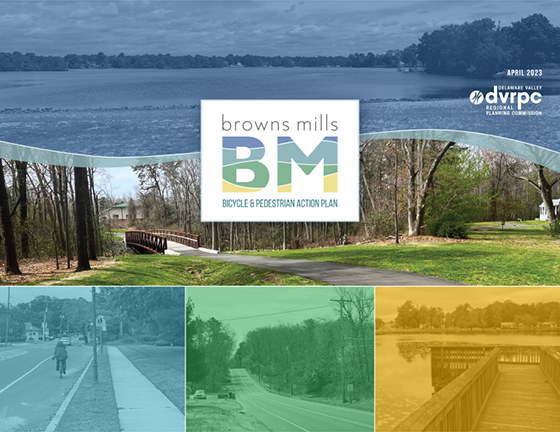
The Browns Mills Bicycle and Pedestrian Action Plan presents a set of bicycle and pedestrian recommendations for Browns Mills, New Jersey, that support better health outcomes and enhance connections to the Town Center, recreational destinations, and neighboring communities. It provides detailed recommendations for five locations throughout and around Browns Mills that the community, Pemberton Township, and Advisory Committee identified as both the highest priority and most achievable. The recommendations build on Browns Mills’ existing bicycle and pedestrian infrastructure with facilities that will create safer and more complete roads, trails, and intersections. Read the report.
Upcoming LTAP Classes in PA and NJ

The Local Technical Assistance Program (LTAP) provides technical information and expertise to help municipal governments use transportation funds more effectively, improve road maintenance, and increase roadway safety. Classes are open to any municipality and offered through Pennsylvania and New Jersey LTAP programs.
Upcoming classes:
Engineering Ethics
Virtual
June 14, 2023 (9:00 am - 12:00 pm)
Stormwater Control Measures
Virtual
June 20, 2023 (8:00 am - 11:00 am)
Visit Rutgers Center for Advanced Infrastructure and Transportation to see the 2023 schedule of LTAP courses in New Jersey and PennDOT's LTAP website to view courses in Pennsylvania. For any questions, contact Najah Jackson at njackson@dvrpc.org or 215-238-2836.
TMAs Honor DVRPC Staff and Projects
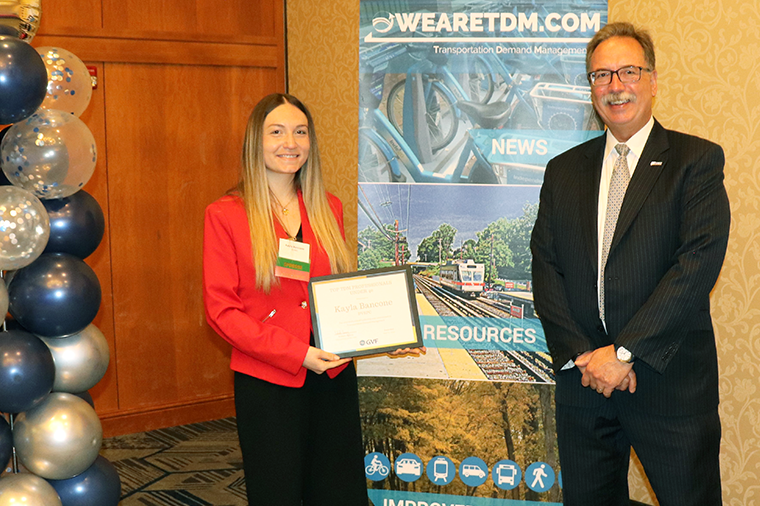

At its 33rd Annual Meeting, transportation management association GVF recognized Kayla Bancone, Transportation Planner, and Joe Natale, Senior Project Implementation Engineer, as Top TDM Professionals Under 40. Now in its tenth year, this award recognizes the next generation of professionals working to find creative solutions to improve quality of life through alternatives to driving alone.
At the Transportation Management Association of Chester County’s 2023 Annual Membership Breakfast, Kristen Scudder, Manager, Freight Programs, accepted a Community Award for the Chester County Freight Plan work in partnership with the Chester County Planning Commission. A highlight was the web map collection tool that was used to engage the community and identify issues and locations of concern regarding freight activity in the county.
Staff Profile: Amy Verbofsky, Manager of Healthy and Resilient Communities

What did you want to be growing up?
As a kid I wanted to be President of the United States until I realized how much public speaking it involved. I also wanted to be a chemical engineer because my parents were chemical engineers, but I learned that chemistry was not my strongest subject.
What did you study in college?
I studied architecture in college. In high school, I liked math and art and I thought architecture was a good combination of the two. I also did a minor in American history, focusing on more recent American history.
How did you end up at DVRPC?
I started at DVRPC as a food systems planning intern during my first semester of graduate school and continued as an intern throughout grad school. I was able to transition into a full-time permanent position when a job opened up in the Office of Environmental Planning (now known as the Office of Climate and Environment).
What are your responsibilities?
I manage our Healthy Communities Planning work, which focuses on how the built environment affects how healthy people can be. We convene the Healthy Communities Task Force, which brings together folks who are interested in the intersection of planning and public health. We also partner with communities and stakeholders to develop food system- and healthy community-related studies, such as the Camden Health Element and the Trenton Air Quality and Health Study. I also support DVRPC’s environmental planning work, focusing on coastal resiliency.
What has changed about your responsibilities?
When I started, my work was primarily focused on food systems planning. In 2014, we started focusing more broadly on healthy communities planning, with food systems falling under that umbrella. And while climate change has been an issue for many years, the awareness and importance of it has only grown, so coastal resiliency has become a bigger focus of my work in more recent years.
What is your favorite leisure activity?
Being active: running, spinning, hiking, being outside when I can. Also, baking and reading when I have the time.
What is the last book you read?
I’ve been listening to a lot of audiobooks, either while commuting or while doing chores at home. Recently, I’ve listened to The Diamond Eye by Kate Quinn and Beneath a Scarlet Sky by Mark Sullivan. I tend to listen to a lot of WWII era historical fiction.
What are the top 3 places you would like to travel to?
I’d like to go to Italy—Rome, Venice, Sicily, Cinque Terre, Lake Como—all of it. I’d also like to go back to Menorca, one of the Balearic islands off the coast of Spain. My husband and I went there on our honeymoon and it was beautiful. It has fantastic beaches, hiking, food, and a few historic cities. After that, it is just a long list of places I’d like to travel internationally, like Switzerland, New Zealand, and Mexico City.
What are you looking forward to most in the next year?
I’m really looking forward to the summer, being outside and spending lots of time at the shore with family and friends.
What is a recent gift you’ve given or received?
For my birthday my husband gave me a certificate to take a glass blowing class at East Falls Glassworks. We both watched the Netflix show “Blown Away” and really liked the idea of glass blowing, so I’m excited to go try that out. We’ll see, we might be totally terrible at it, but it should be fun!